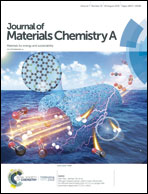Nitrogen-doped tubular carbon foam electrodes for efficient electroreduction of CO2 to syngas with potential-independent CO/H2 ratios†
Abstract
Electrochemical reduction of CO2 is a promising strategy to produce syngas, which is an essential feedstock for production of different industrial chemicals. However, it remains a great challenge to realize stable electrosynthesis of syngas with potential-independent CO/H2 ratios due to the limited mass transport and inefficient catalytic interface. Herein, a series of nitrogen-doped tubular carbon foam electrodes were designed and used as both gas diffusers and self-supported electrocatalysts. Owing to the direct delivery of CO2, forced convection flow and tunable number of active sites, the monolithic tubular electrodes enable efficient electrosynthesis of syngas with tuned CO/H2 ratios (1 : 3 to 2 : 1) by CO2 reduction in a wide potential range (−0.5 V to −1.3 V vs. RHE). Experimental and simulation studies reveal that the novel tubular carbon foam configuration significantly enhances the mass transport and provides an efficient triple-phase catalytic interface, resulting in relatively stable syngas production in the high-overpotential region.



 Please wait while we load your content...
Please wait while we load your content...